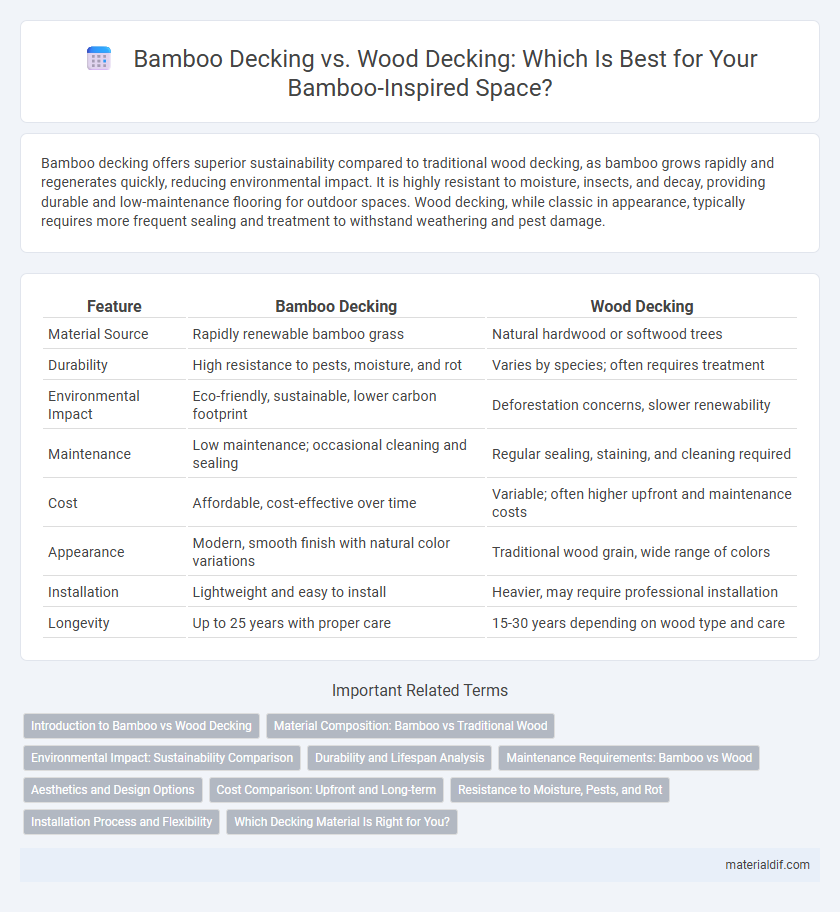Bamboo decking offers superior sustainability compared to traditional wood decking, as bamboo grows rapidly and regenerates quickly, reducing environmental impact. It is highly resistant to moisture, insects, and decay, providing durable and low-maintenance flooring for outdoor spaces. Wood decking, while classic in appearance, typically requires more frequent sealing and treatment to withstand weathering and pest damage.
Table of Comparison
| Feature | Bamboo Decking | Wood Decking |
|---|---|---|
| Material Source | Rapidly renewable bamboo grass | Natural hardwood or softwood trees |
| Durability | High resistance to pests, moisture, and rot | Varies by species; often requires treatment |
| Environmental Impact | Eco-friendly, sustainable, lower carbon footprint | Deforestation concerns, slower renewability |
| Maintenance | Low maintenance; occasional cleaning and sealing | Regular sealing, staining, and cleaning required |
| Cost | Affordable, cost-effective over time | Variable; often higher upfront and maintenance costs |
| Appearance | Modern, smooth finish with natural color variations | Traditional wood grain, wide range of colors |
| Installation | Lightweight and easy to install | Heavier, may require professional installation |
| Longevity | Up to 25 years with proper care | 15-30 years depending on wood type and care |
Introduction to Bamboo vs Wood Decking
Bamboo decking offers a sustainable alternative to traditional wood decking, featuring rapid growth rates that reduce environmental impact. Unlike wood, bamboo is naturally resistant to moisture, insects, and decay, enhancing durability and longevity in outdoor settings. This renewable material also boasts a high strength-to-weight ratio, making it ideal for sturdy, lightweight decking solutions.
Material Composition: Bamboo vs Traditional Wood
Bamboo decking is made from rapidly renewable grass fibers compressed into dense boards, offering higher tensile strength and natural resistance to moisture and insects compared to traditional wood decking, which originates from slower-growing hardwoods or softwoods with variable durability. The engineered composition of bamboo often includes binding agents and heat treatments that enhance its stability and longevity, while wood decking varies widely in hardness, porosity, and susceptibility to warping or decay depending on species and treatment. Bamboo's uniform texture and dimensional stability provide a consistent surface with fewer imperfections than natural wood, making it an eco-friendly alternative for sustainable decking solutions.
Environmental Impact: Sustainability Comparison
Bamboo decking offers a more sustainable alternative to traditional wood decking due to its rapid growth rate and renewability, with bamboo reaching maturity in 3-5 years compared to decades for hardwood trees. Harvesting bamboo has a lower environmental footprint, requiring less water, fertilizer, and pesticides while promoting soil stabilization and reducing deforestation pressures on natural forests. The carbon sequestration capacity of bamboo is higher than most woods, making it an eco-friendly choice for decking that supports carbon-neutral construction practices.
Durability and Lifespan Analysis
Bamboo decking outperforms traditional wood decking in durability due to its natural resistance to moisture, insects, and decay, extending its lifespan significantly. Engineered bamboo decking can last up to 25-30 years with proper maintenance, surpassing many hardwoods that typically endure 10-15 years under similar conditions. The high tensile strength of bamboo fibers contributes to enhanced structural integrity, making it a sustainable and long-lasting alternative for outdoor decking solutions.
Maintenance Requirements: Bamboo vs Wood
Bamboo decking requires significantly less maintenance compared to traditional wood decking due to its natural resistance to moisture, insects, and decay. Unlike wood, which often demands regular sealing, staining, and sanding to prevent warping and rotting, bamboo decking typically only needs periodic cleaning with mild soap and water. This reduced upkeep makes bamboo decking a more sustainable and cost-effective option for long-term outdoor flooring durability.
Aesthetics and Design Options
Bamboo decking offers a modern, sleek appearance with a natural golden hue that darkens gracefully over time, providing a unique aesthetic compared to traditional wood decking. Its consistent grain and smooth texture allow for seamless, contemporary design options, while wood decking provides a wider variety of natural color tones and rustic charm due to its diverse species and grain patterns. Bamboo's uniformity and capacity for innovative finishes make it a popular choice for minimalist and eco-friendly design projects, enhancing outdoor spaces with a fresh, sustainable look.
Cost Comparison: Upfront and Long-term
Bamboo decking generally offers a lower upfront cost compared to traditional wood decking due to its rapid growth and sustainable harvesting methods. Long-term expenses favor bamboo as well, since its natural resistance to moisture, insects, and UV damage reduces maintenance and replacement costs over time. In contrast, wood decking often demands regular sealing, staining, and repairs, increasing overall lifecycle costs despite sometimes lower initial prices.
Resistance to Moisture, Pests, and Rot
Bamboo decking outperforms traditional wood decking in resistance to moisture, pests, and rot due to its dense fiber structure and natural silica content. Unlike many wood species, bamboo is less susceptible to fungal decay and termite damage, ensuring longer durability in damp environments. Properly treated bamboo decking maintains structural integrity and aesthetic appeal even under constant exposure to humidity and insects.
Installation Process and Flexibility
Bamboo decking offers a straightforward installation process with interlocking systems that reduce labor time compared to traditional wood decking, which often requires nails or screws and precise alignment. Bamboo's dimensional stability and resistance to warping provide greater flexibility in design, allowing for curved or custom layouts that wood decking may struggle to accommodate. These qualities make bamboo decking a versatile, low-maintenance alternative suited for both DIY projects and professional installations.
Which Decking Material Is Right for You?
Bamboo decking offers exceptional durability and sustainability compared to traditional wood decking, making it an eco-friendly choice for outdoor spaces. Engineered bamboo resists moisture, insects, and warping better than many hardwoods, ensuring a longer lifespan with lower maintenance requirements. Wood decking provides natural aesthetics and familiar textures but may require frequent sealing and repairs due to susceptibility to rot and pests.
Bamboo decking vs wood decking Infographic

 materialdif.com
materialdif.com